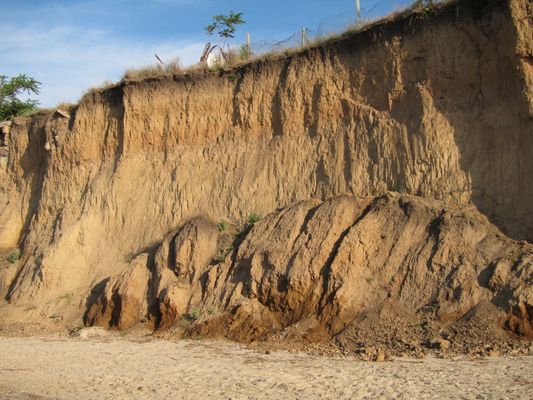3.3.2
Coastal Retreat
Coastal Recession
Coastal Recession
The rapid recession of coastlines is caused by a combination of physical and human factors.


Dredging
Dredging
- Dredging involves the removal of sediment for use in construction. But this process has been linked to increased rates of coastal retreat.
- Removal of the sediment causes the depth of the ocean to increase.
- This can cause an increase in the occurrence of destructive waves at the coast because they can maintain their energy further towards the shoreline.


Hard engineering
Hard engineering
- The construction of hard engineering structures at the coastline can disrupt sediment cells.
- This means that by disrupting one bit of coast, areas further along the coast may be starved of sediment supply, which can then result in the destruction of beaches.


Dredging in California
Dredging in California
- Dredging along the coastline of California has had long-term implications on the supply of sediment to the Santa Barbara littoral cell.


Subaerial processes
Subaerial processes
- Weathering and mass movement processes combine to increase the rate of coastal recession.
- Long periods of rainfall weaken rock structure and in turn, leads to mass movement of material.
- This collapsed material is then eroded and transported away by wave action.
Rate of Coastal Recession
Rate of Coastal Recession
The rate of coastal recession varies and caused by several factors. These include: short and long-term wind direction, tides, seasons, weather systems and storm occurrence.


Wind direction
Wind direction
- Wind direction controls the movement of waves, influencing the rate of coastal erosion.
- A dominant wind direction causes powerful destructive waves to attack the coastline.
- E.g. the south-westerly wind directing waves across the Atlantic Ocean towards Land’s End in Cornwall.
- This happens because the waves have travelled a long distance, influenced by the dominant wind, which is linked to the fetch of a wave.


Tides
Tides
- Tides are linked to gravitational pull. When the pull is at its strongest, there are high tides. When the pull is at its weakest, there are low tides.
- During periods of high tide, the rate of coastal recession can increase because waves can reach further towards the shore.


Seasons
Seasons
- During the winter season, the rate of coastal recession tends to be greater than during the summer season.
- This is because winter brings stormy weather, linked with higher tides and long wave fetch.
- The average rate of erosion increases at this time of the year.


Weather systems
Weather systems
- Weather systems are influenced by areas of high pressure, creating anticyclones, and areas of low pressure, creating depressions.
- Increased belts of high pressure reduce the rate of coastal recession because this leads to calmer weather.
- Belts of low pressure systems cause unsettled weather conditions.
1Tectonic Processes & Hazards
1.1Tectonic Processes & Hazards
1.2Natural Disasters
1.3Natural Disaster Case Studies
1.4Trends & Patterns
2Option 2A: Glaciated Landscapes & Change
2.1Glaciated Landscapes Over Time
2.2Periglacial Landscapes
2.3Glacial Processes
2.4Glacial Landforms
3Option 2B: Coastal Landscapes & Change
3.1Coastal Landscapes
3.2Coastal Erosion & Deposition
3.3Coastal Risks
4Globalisation
4.1Globalisation
4.2Negatives of Globalisation
4.3Global Shift
4.5Culture
4.6Measuring Development
5Option 4A: Regenerating Places
5.1Types of Economies
5.2Function of Places
5.3Regeneration
5.4Regeneration Case Studies
6Option 4B: Diverse Places
6.1Population Structure
6.2Past & Present Connections
6.3Urban & Rural Spaces
6.4Diversity
6.5Urban & Rural Case Studies
6.6Case Study - Tower Hamlets
6.7Case Study - Sturton-le-Steeple
7The Water Cycle & Water Insecurity (A2 only)
7.1Hydrological Processes Global to Local
7.2Influences on the Water Cycle
7.3Water Insecurity
8The Carbon Cycle & Energy Security (A2 only)
8.1The Carbon Cycle
8.2Energy Consumption
8.3Alternative Energy
8.4Growing Demand for Resources
9Superpowers (A2 only)
9.1Superpowers
9.2Hard & Soft Power
9.2.1Hard & Soft Power
9.2.2Emerging Powers - China Rivalry
9.2.3Emerging Powers - Chinese Sources of Power
9.2.4Emerging Powers - Brazil
9.2.5Emerging Powers - Russia
9.2.6Emerging Powers - India
9.2.7Theories of Development
9.2.8Power Case Studies: Chinese One Belt One Road
9.2.9Power Case Studies: Pakistan Nuclear Arms
9.2.10Power Case Studies: OPEC
9.3IGOs, TNCs & Alliances
10Option 8A: Health & Human Rights (A2 only)
10.1Human Development
10.2Role of Governments & IGOs
10.3Human Rights
10.4Interventions
11Option 8B: Migration & Identity (A2 only)
11.1Globalisation & Migration
11.2Consequences of Migration
11.3Nation States
11.4Responses to Global Migration
Jump to other topics
1Tectonic Processes & Hazards
1.1Tectonic Processes & Hazards
1.2Natural Disasters
1.3Natural Disaster Case Studies
1.4Trends & Patterns
2Option 2A: Glaciated Landscapes & Change
2.1Glaciated Landscapes Over Time
2.2Periglacial Landscapes
2.3Glacial Processes
2.4Glacial Landforms
3Option 2B: Coastal Landscapes & Change
3.1Coastal Landscapes
3.2Coastal Erosion & Deposition
3.3Coastal Risks
4Globalisation
4.1Globalisation
4.2Negatives of Globalisation
4.3Global Shift
4.5Culture
4.6Measuring Development
5Option 4A: Regenerating Places
5.1Types of Economies
5.2Function of Places
5.3Regeneration
5.4Regeneration Case Studies
6Option 4B: Diverse Places
6.1Population Structure
6.2Past & Present Connections
6.3Urban & Rural Spaces
6.4Diversity
6.5Urban & Rural Case Studies
6.6Case Study - Tower Hamlets
6.7Case Study - Sturton-le-Steeple
7The Water Cycle & Water Insecurity (A2 only)
7.1Hydrological Processes Global to Local
7.2Influences on the Water Cycle
7.3Water Insecurity
8The Carbon Cycle & Energy Security (A2 only)
8.1The Carbon Cycle
8.2Energy Consumption
8.3Alternative Energy
8.4Growing Demand for Resources
9Superpowers (A2 only)
9.1Superpowers
9.2Hard & Soft Power
9.2.1Hard & Soft Power
9.2.2Emerging Powers - China Rivalry
9.2.3Emerging Powers - Chinese Sources of Power
9.2.4Emerging Powers - Brazil
9.2.5Emerging Powers - Russia
9.2.6Emerging Powers - India
9.2.7Theories of Development
9.2.8Power Case Studies: Chinese One Belt One Road
9.2.9Power Case Studies: Pakistan Nuclear Arms
9.2.10Power Case Studies: OPEC
9.3IGOs, TNCs & Alliances
10Option 8A: Health & Human Rights (A2 only)
10.1Human Development
10.2Role of Governments & IGOs
10.3Human Rights
10.4Interventions
11Option 8B: Migration & Identity (A2 only)
11.1Globalisation & Migration
11.2Consequences of Migration
11.3Nation States
11.4Responses to Global Migration
Unlock your full potential with Seneca Premium
Unlimited access to 10,000+ open-ended exam questions
Mini-mock exams based on your study history
Unlock 800+ premium courses & e-books